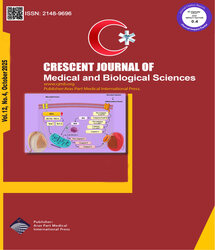

| Original Article | |
| Comparison of Changes in Serum Creatinine and PNGAL in Predicting Renal Damage in Brucellosis Patients Receiving Gentamycin | |
| Freidoon Poorshahbaz1, Afsane Karami1, Manigheh Jozpanahi1, Ayyub Pezeshki2, Sograt Fagihzadeh3, Abdolreza Esmailzadeh4, Rogayeh Moosazadeh5, Mohammadreza Behmanesh6, Mina Kiafar6, Mahshid Kashkuli6 | |
| 1Department of Infectious Diseases and Tropical Medicine, Zanjan University of Medical Sciences, Zanjan, Iran 2Department of Nephrology, Zanjan University of Medical Sciences, Zanjan, Iran 3Department of Statistics, Zanjan University of Medical Sciences, Zanjan, Iran 4Department of Immunology, Zanjan University of Medical Sciences, Zanjan, Iran 5Women’s Reproductive Health Research Center, Tabriz University of Medical Sciences, Tabriz, Iran 6Department of Internal Medicine, Zanjan University of Medical Sciences, Zanjan, Iran |
|
|
CJMB 2015; 2: 116-120 Viewed : 4435 times Downloaded : 3537 times. Keywords : Serum neutrophil gelatinase-associated lipocalin, Acute kidney injury, Brucellosis, Gentamycin |
|
| Full Text(PDF) | Related Articles | |
| Abstract | |
Objective: Treatment with aminoglycosides is a preventable cause of acute kidney injury (AKI). Early predictive markers of AKI are crucial in preventing this condition. This study aimed to examine the role of serum neutrophil gelatinase-associated lipocalin (NGAL) level as a predictive marker of AKI in patients receiving gentamicin. Materials and Methods: In this prospective study, 37 patients with brucellosis (23 males, 14 females; mean age = 10.7 ± 33.7 years) were studied in a health center between March 2013 and March 2014. Serum creatinine and NGAL levels at baseline, and 3, 5 and 7 days after the administration of gentamicin were measured. In this study, a 25% increase in the serum creatinine levels compared with the baseline levels was considered a criterion for AKI risk. Results: The frequencies of patients prone to AKI at the first, third, fifth and seventh day of administration of gentamicin were 0%, 8.1%, 18.9%, and 13.5%, respectively. In total, 24.3% of the patients (n = 9) were prone to AKI. No statistically significant difference was observed between NGAL levels before and after the administration of gentamicin (P = .082). Conclusion: The serum NGAL level is not a sensitive and specific predictor of AKI following the administration of gentamicin. Therefore it is recommended to increase the frequency of sNGAL measurement and using more sensitive kits in more patients. |
Cite By, Google Scholar
Google Scholar
PubMed
Online Submission System
 CJMB ENDNOTE ® Style
CJMB ENDNOTE ® Style
 Tutorials
Tutorials
 Publication Charge
Medical and Biological Research Center
About Journal
Publication Charge
Medical and Biological Research Center
About Journal
Aras Part Medical International Press Editor-in-Chief
Arash Khaki
Deputy Editor
Zafer Akan

















